Critique of 'Mental Health Nurses' Views' Nursing Article, 2018
VerifiedAdded on 2023/01/18
|10
|4519
|49
Report
AI Summary
This report provides a critical appraisal of the journal article "Mental health nurses' views and experiences of working with undergraduate nursing students: A descriptive exploratory study" by Brown et al. (2018). The critique, using the Rapid Critical Appraisal Checklists for nursing, examines the believability and robustness of the study, including its title, abstract, author credentials, research problem, literature review, study design, sampling, data collection, and analysis. The report highlights the study's strengths, such as its clear purpose and comprehensive literature review, while also pointing out limitations like the use of convenience sampling. The analysis emphasizes the importance of clinical placements in nursing education and the impact of registered nurses' views on student learning. The report concludes with a discussion of the study's implications for nursing practice and education, emphasizing the need for further research to improve the clinical learning environment for nursing students, particularly in mental health settings. The study's relevance to evidence-based practice is underscored throughout the critique, reflecting its significance in contemporary healthcare.
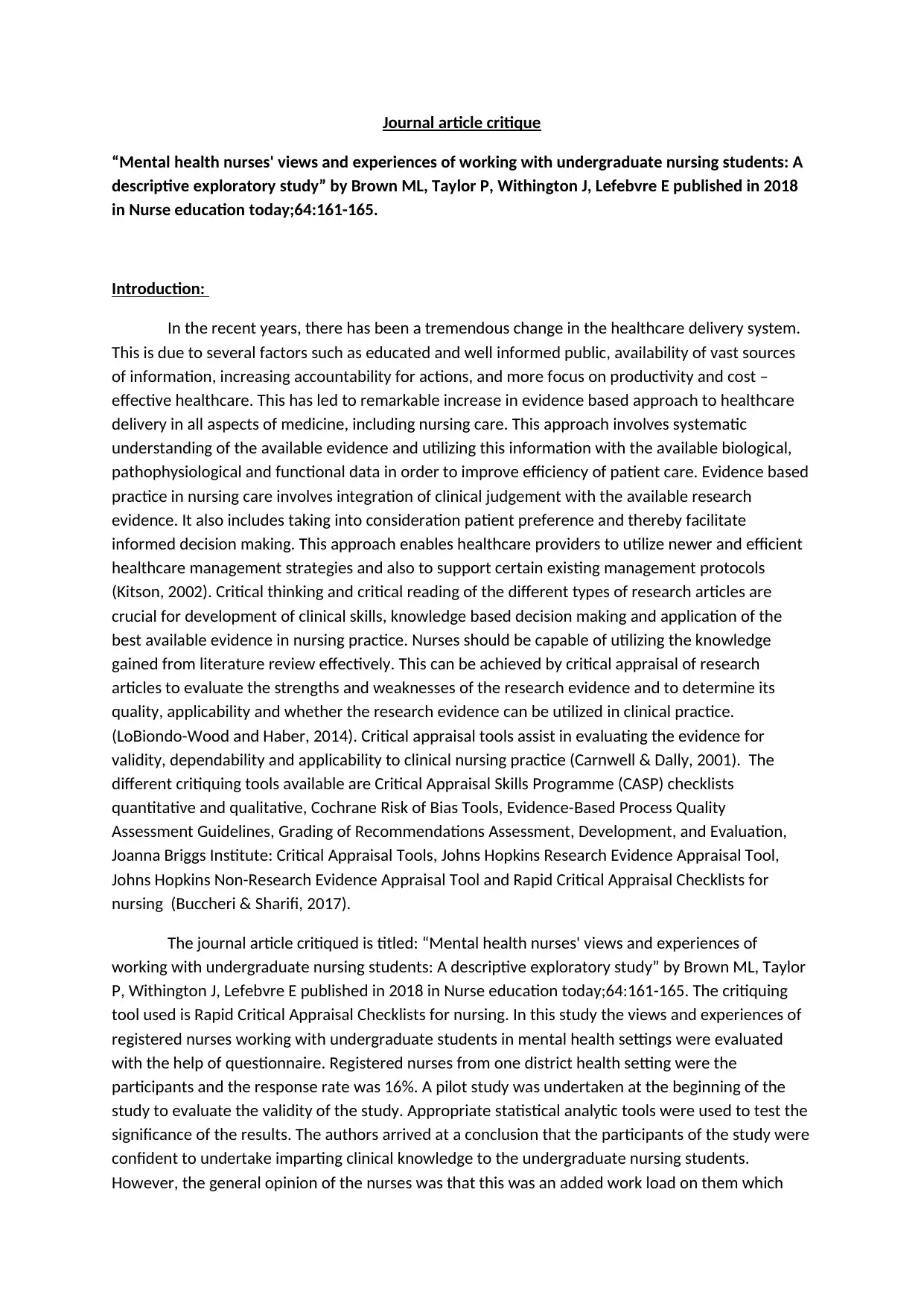
Journal article critique
“Mental health nurses' views and experiences of working with undergraduate nursing students: A
descriptive exploratory study” by Brown ML, Taylor P, Withington J, Lefebvre E published in 2018
in Nurse education today;64:161-165.
Introduction:
In the recent years, there has been a tremendous change in the healthcare delivery system.
This is due to several factors such as educated and well informed public, availability of vast sources
of information, increasing accountability for actions, and more focus on productivity and cost –
effective healthcare. This has led to remarkable increase in evidence based approach to healthcare
delivery in all aspects of medicine, including nursing care. This approach involves systematic
understanding of the available evidence and utilizing this information with the available biological,
pathophysiological and functional data in order to improve efficiency of patient care. Evidence based
practice in nursing care involves integration of clinical judgement with the available research
evidence. It also includes taking into consideration patient preference and thereby facilitate
informed decision making. This approach enables healthcare providers to utilize newer and efficient
healthcare management strategies and also to support certain existing management protocols
(Kitson, 2002). Critical thinking and critical reading of the different types of research articles are
crucial for development of clinical skills, knowledge based decision making and application of the
best available evidence in nursing practice. Nurses should be capable of utilizing the knowledge
gained from literature review effectively. This can be achieved by critical appraisal of research
articles to evaluate the strengths and weaknesses of the research evidence and to determine its
quality, applicability and whether the research evidence can be utilized in clinical practice.
(LoBiondo-Wood and Haber, 2014). Critical appraisal tools assist in evaluating the evidence for
validity, dependability and applicability to clinical nursing practice (Carnwell & Dally, 2001). The
different critiquing tools available are Critical Appraisal Skills Programme (CASP) checklists
quantitative and qualitative, Cochrane Risk of Bias Tools, Evidence-Based Process Quality
Assessment Guidelines, Grading of Recommendations Assessment, Development, and Evaluation,
Joanna Briggs Institute: Critical Appraisal Tools, Johns Hopkins Research Evidence Appraisal Tool,
Johns Hopkins Non-Research Evidence Appraisal Tool and Rapid Critical Appraisal Checklists for
nursing (Buccheri & Sharifi, 2017).
The journal article critiqued is titled: “Mental health nurses' views and experiences of
working with undergraduate nursing students: A descriptive exploratory study” by Brown ML, Taylor
P, Withington J, Lefebvre E published in 2018 in Nurse education today;64:161-165. The critiquing
tool used is Rapid Critical Appraisal Checklists for nursing. In this study the views and experiences of
registered nurses working with undergraduate students in mental health settings were evaluated
with the help of questionnaire. Registered nurses from one district health setting were the
participants and the response rate was 16%. A pilot study was undertaken at the beginning of the
study to evaluate the validity of the study. Appropriate statistical analytic tools were used to test the
significance of the results. The authors arrived at a conclusion that the participants of the study were
confident to undertake imparting clinical knowledge to the undergraduate nursing students.
However, the general opinion of the nurses was that this was an added work load on them which
“Mental health nurses' views and experiences of working with undergraduate nursing students: A
descriptive exploratory study” by Brown ML, Taylor P, Withington J, Lefebvre E published in 2018
in Nurse education today;64:161-165.
Introduction:
In the recent years, there has been a tremendous change in the healthcare delivery system.
This is due to several factors such as educated and well informed public, availability of vast sources
of information, increasing accountability for actions, and more focus on productivity and cost –
effective healthcare. This has led to remarkable increase in evidence based approach to healthcare
delivery in all aspects of medicine, including nursing care. This approach involves systematic
understanding of the available evidence and utilizing this information with the available biological,
pathophysiological and functional data in order to improve efficiency of patient care. Evidence based
practice in nursing care involves integration of clinical judgement with the available research
evidence. It also includes taking into consideration patient preference and thereby facilitate
informed decision making. This approach enables healthcare providers to utilize newer and efficient
healthcare management strategies and also to support certain existing management protocols
(Kitson, 2002). Critical thinking and critical reading of the different types of research articles are
crucial for development of clinical skills, knowledge based decision making and application of the
best available evidence in nursing practice. Nurses should be capable of utilizing the knowledge
gained from literature review effectively. This can be achieved by critical appraisal of research
articles to evaluate the strengths and weaknesses of the research evidence and to determine its
quality, applicability and whether the research evidence can be utilized in clinical practice.
(LoBiondo-Wood and Haber, 2014). Critical appraisal tools assist in evaluating the evidence for
validity, dependability and applicability to clinical nursing practice (Carnwell & Dally, 2001). The
different critiquing tools available are Critical Appraisal Skills Programme (CASP) checklists
quantitative and qualitative, Cochrane Risk of Bias Tools, Evidence-Based Process Quality
Assessment Guidelines, Grading of Recommendations Assessment, Development, and Evaluation,
Joanna Briggs Institute: Critical Appraisal Tools, Johns Hopkins Research Evidence Appraisal Tool,
Johns Hopkins Non-Research Evidence Appraisal Tool and Rapid Critical Appraisal Checklists for
nursing (Buccheri & Sharifi, 2017).
The journal article critiqued is titled: “Mental health nurses' views and experiences of
working with undergraduate nursing students: A descriptive exploratory study” by Brown ML, Taylor
P, Withington J, Lefebvre E published in 2018 in Nurse education today;64:161-165. The critiquing
tool used is Rapid Critical Appraisal Checklists for nursing. In this study the views and experiences of
registered nurses working with undergraduate students in mental health settings were evaluated
with the help of questionnaire. Registered nurses from one district health setting were the
participants and the response rate was 16%. A pilot study was undertaken at the beginning of the
study to evaluate the validity of the study. Appropriate statistical analytic tools were used to test the
significance of the results. The authors arrived at a conclusion that the participants of the study were
confident to undertake imparting clinical knowledge to the undergraduate nursing students.
However, the general opinion of the nurses was that this was an added work load on them which
Paraphrase This Document
Need a fresh take? Get an instant paraphrase of this document with our AI Paraphraser
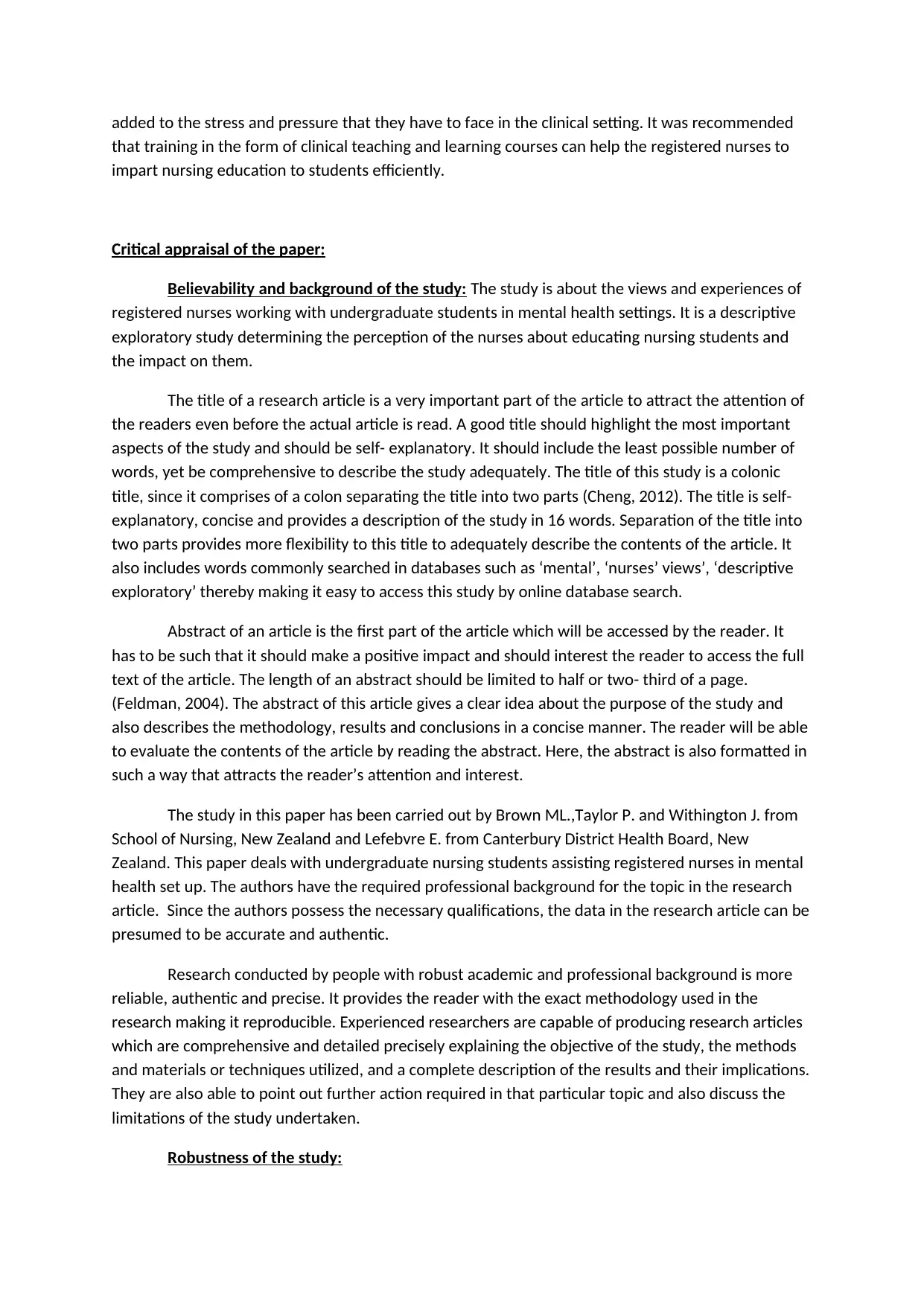
added to the stress and pressure that they have to face in the clinical setting. It was recommended
that training in the form of clinical teaching and learning courses can help the registered nurses to
impart nursing education to students efficiently.
Critical appraisal of the paper:
Believability and background of the study: The study is about the views and experiences of
registered nurses working with undergraduate students in mental health settings. It is a descriptive
exploratory study determining the perception of the nurses about educating nursing students and
the impact on them.
The title of a research article is a very important part of the article to attract the attention of
the readers even before the actual article is read. A good title should highlight the most important
aspects of the study and should be self- explanatory. It should include the least possible number of
words, yet be comprehensive to describe the study adequately. The title of this study is a colonic
title, since it comprises of a colon separating the title into two parts (Cheng, 2012). The title is self-
explanatory, concise and provides a description of the study in 16 words. Separation of the title into
two parts provides more flexibility to this title to adequately describe the contents of the article. It
also includes words commonly searched in databases such as ‘mental’, ‘nurses’ views’, ‘descriptive
exploratory’ thereby making it easy to access this study by online database search.
Abstract of an article is the first part of the article which will be accessed by the reader. It
has to be such that it should make a positive impact and should interest the reader to access the full
text of the article. The length of an abstract should be limited to half or two- third of a page.
(Feldman, 2004). The abstract of this article gives a clear idea about the purpose of the study and
also describes the methodology, results and conclusions in a concise manner. The reader will be able
to evaluate the contents of the article by reading the abstract. Here, the abstract is also formatted in
such a way that attracts the reader’s attention and interest.
The study in this paper has been carried out by Brown ML.,Taylor P. and Withington J. from
School of Nursing, New Zealand and Lefebvre E. from Canterbury District Health Board, New
Zealand. This paper deals with undergraduate nursing students assisting registered nurses in mental
health set up. The authors have the required professional background for the topic in the research
article. Since the authors possess the necessary qualifications, the data in the research article can be
presumed to be accurate and authentic.
Research conducted by people with robust academic and professional background is more
reliable, authentic and precise. It provides the reader with the exact methodology used in the
research making it reproducible. Experienced researchers are capable of producing research articles
which are comprehensive and detailed precisely explaining the objective of the study, the methods
and materials or techniques utilized, and a complete description of the results and their implications.
They are also able to point out further action required in that particular topic and also discuss the
limitations of the study undertaken.
Robustness of the study:
that training in the form of clinical teaching and learning courses can help the registered nurses to
impart nursing education to students efficiently.
Critical appraisal of the paper:
Believability and background of the study: The study is about the views and experiences of
registered nurses working with undergraduate students in mental health settings. It is a descriptive
exploratory study determining the perception of the nurses about educating nursing students and
the impact on them.
The title of a research article is a very important part of the article to attract the attention of
the readers even before the actual article is read. A good title should highlight the most important
aspects of the study and should be self- explanatory. It should include the least possible number of
words, yet be comprehensive to describe the study adequately. The title of this study is a colonic
title, since it comprises of a colon separating the title into two parts (Cheng, 2012). The title is self-
explanatory, concise and provides a description of the study in 16 words. Separation of the title into
two parts provides more flexibility to this title to adequately describe the contents of the article. It
also includes words commonly searched in databases such as ‘mental’, ‘nurses’ views’, ‘descriptive
exploratory’ thereby making it easy to access this study by online database search.
Abstract of an article is the first part of the article which will be accessed by the reader. It
has to be such that it should make a positive impact and should interest the reader to access the full
text of the article. The length of an abstract should be limited to half or two- third of a page.
(Feldman, 2004). The abstract of this article gives a clear idea about the purpose of the study and
also describes the methodology, results and conclusions in a concise manner. The reader will be able
to evaluate the contents of the article by reading the abstract. Here, the abstract is also formatted in
such a way that attracts the reader’s attention and interest.
The study in this paper has been carried out by Brown ML.,Taylor P. and Withington J. from
School of Nursing, New Zealand and Lefebvre E. from Canterbury District Health Board, New
Zealand. This paper deals with undergraduate nursing students assisting registered nurses in mental
health set up. The authors have the required professional background for the topic in the research
article. Since the authors possess the necessary qualifications, the data in the research article can be
presumed to be accurate and authentic.
Research conducted by people with robust academic and professional background is more
reliable, authentic and precise. It provides the reader with the exact methodology used in the
research making it reproducible. Experienced researchers are capable of producing research articles
which are comprehensive and detailed precisely explaining the objective of the study, the methods
and materials or techniques utilized, and a complete description of the results and their implications.
They are also able to point out further action required in that particular topic and also discuss the
limitations of the study undertaken.
Robustness of the study:
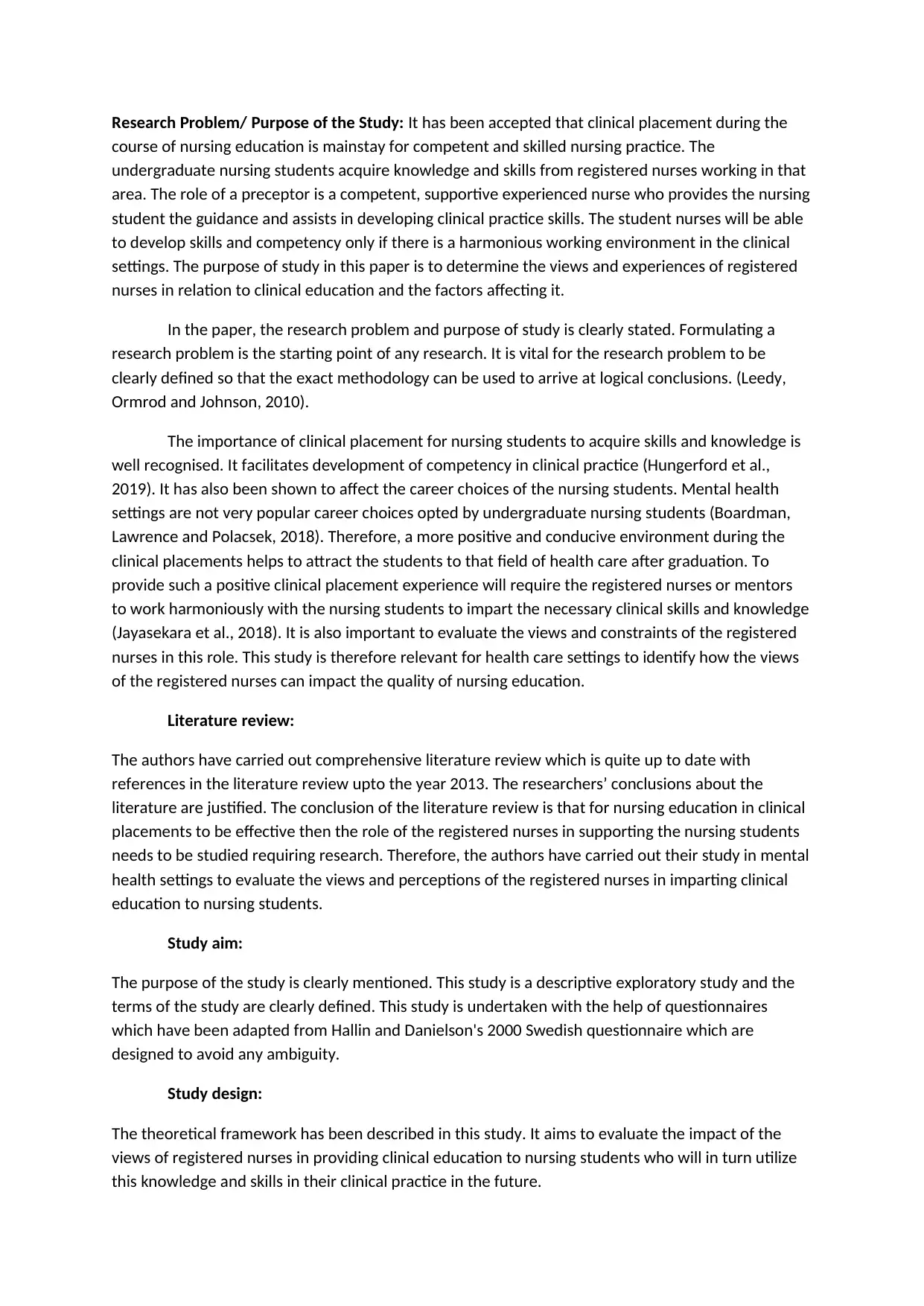
Research Problem/ Purpose of the Study: It has been accepted that clinical placement during the
course of nursing education is mainstay for competent and skilled nursing practice. The
undergraduate nursing students acquire knowledge and skills from registered nurses working in that
area. The role of a preceptor is a competent, supportive experienced nurse who provides the nursing
student the guidance and assists in developing clinical practice skills. The student nurses will be able
to develop skills and competency only if there is a harmonious working environment in the clinical
settings. The purpose of study in this paper is to determine the views and experiences of registered
nurses in relation to clinical education and the factors affecting it.
In the paper, the research problem and purpose of study is clearly stated. Formulating a
research problem is the starting point of any research. It is vital for the research problem to be
clearly defined so that the exact methodology can be used to arrive at logical conclusions. (Leedy,
Ormrod and Johnson, 2010).
The importance of clinical placement for nursing students to acquire skills and knowledge is
well recognised. It facilitates development of competency in clinical practice (Hungerford et al.,
2019). It has also been shown to affect the career choices of the nursing students. Mental health
settings are not very popular career choices opted by undergraduate nursing students (Boardman,
Lawrence and Polacsek, 2018). Therefore, a more positive and conducive environment during the
clinical placements helps to attract the students to that field of health care after graduation. To
provide such a positive clinical placement experience will require the registered nurses or mentors
to work harmoniously with the nursing students to impart the necessary clinical skills and knowledge
(Jayasekara et al., 2018). It is also important to evaluate the views and constraints of the registered
nurses in this role. This study is therefore relevant for health care settings to identify how the views
of the registered nurses can impact the quality of nursing education.
Literature review:
The authors have carried out comprehensive literature review which is quite up to date with
references in the literature review upto the year 2013. The researchers’ conclusions about the
literature are justified. The conclusion of the literature review is that for nursing education in clinical
placements to be effective then the role of the registered nurses in supporting the nursing students
needs to be studied requiring research. Therefore, the authors have carried out their study in mental
health settings to evaluate the views and perceptions of the registered nurses in imparting clinical
education to nursing students.
Study aim:
The purpose of the study is clearly mentioned. This study is a descriptive exploratory study and the
terms of the study are clearly defined. This study is undertaken with the help of questionnaires
which have been adapted from Hallin and Danielson's 2000 Swedish questionnaire which are
designed to avoid any ambiguity.
Study design:
The theoretical framework has been described in this study. It aims to evaluate the impact of the
views of registered nurses in providing clinical education to nursing students who will in turn utilize
this knowledge and skills in their clinical practice in the future.
course of nursing education is mainstay for competent and skilled nursing practice. The
undergraduate nursing students acquire knowledge and skills from registered nurses working in that
area. The role of a preceptor is a competent, supportive experienced nurse who provides the nursing
student the guidance and assists in developing clinical practice skills. The student nurses will be able
to develop skills and competency only if there is a harmonious working environment in the clinical
settings. The purpose of study in this paper is to determine the views and experiences of registered
nurses in relation to clinical education and the factors affecting it.
In the paper, the research problem and purpose of study is clearly stated. Formulating a
research problem is the starting point of any research. It is vital for the research problem to be
clearly defined so that the exact methodology can be used to arrive at logical conclusions. (Leedy,
Ormrod and Johnson, 2010).
The importance of clinical placement for nursing students to acquire skills and knowledge is
well recognised. It facilitates development of competency in clinical practice (Hungerford et al.,
2019). It has also been shown to affect the career choices of the nursing students. Mental health
settings are not very popular career choices opted by undergraduate nursing students (Boardman,
Lawrence and Polacsek, 2018). Therefore, a more positive and conducive environment during the
clinical placements helps to attract the students to that field of health care after graduation. To
provide such a positive clinical placement experience will require the registered nurses or mentors
to work harmoniously with the nursing students to impart the necessary clinical skills and knowledge
(Jayasekara et al., 2018). It is also important to evaluate the views and constraints of the registered
nurses in this role. This study is therefore relevant for health care settings to identify how the views
of the registered nurses can impact the quality of nursing education.
Literature review:
The authors have carried out comprehensive literature review which is quite up to date with
references in the literature review upto the year 2013. The researchers’ conclusions about the
literature are justified. The conclusion of the literature review is that for nursing education in clinical
placements to be effective then the role of the registered nurses in supporting the nursing students
needs to be studied requiring research. Therefore, the authors have carried out their study in mental
health settings to evaluate the views and perceptions of the registered nurses in imparting clinical
education to nursing students.
Study aim:
The purpose of the study is clearly mentioned. This study is a descriptive exploratory study and the
terms of the study are clearly defined. This study is undertaken with the help of questionnaires
which have been adapted from Hallin and Danielson's 2000 Swedish questionnaire which are
designed to avoid any ambiguity.
Study design:
The theoretical framework has been described in this study. It aims to evaluate the impact of the
views of registered nurses in providing clinical education to nursing students who will in turn utilize
this knowledge and skills in their clinical practice in the future.
⊘ This is a preview!⊘
Do you want full access?
Subscribe today to unlock all pages.

Trusted by 1+ million students worldwide
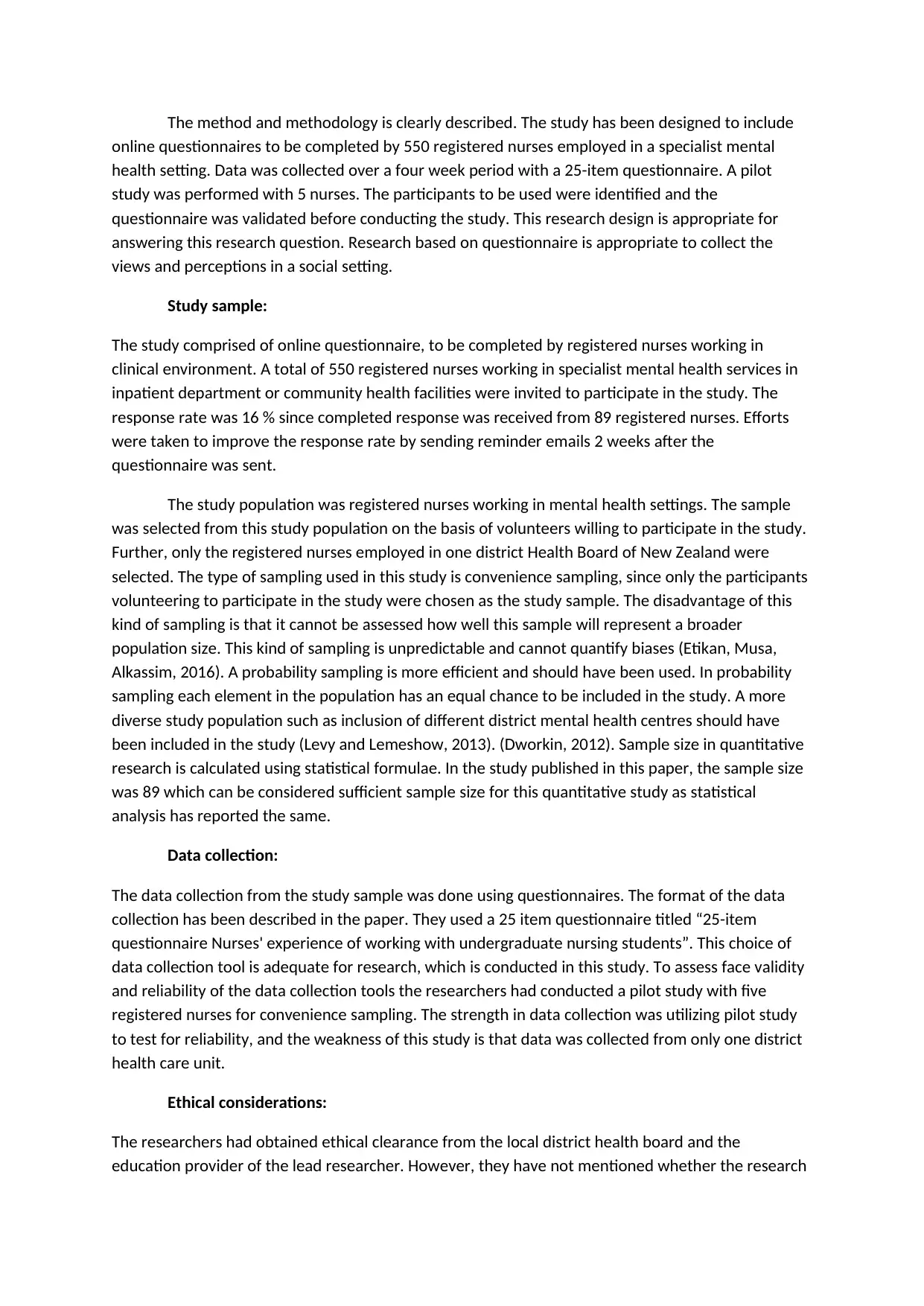
The method and methodology is clearly described. The study has been designed to include
online questionnaires to be completed by 550 registered nurses employed in a specialist mental
health setting. Data was collected over a four week period with a 25-item questionnaire. A pilot
study was performed with 5 nurses. The participants to be used were identified and the
questionnaire was validated before conducting the study. This research design is appropriate for
answering this research question. Research based on questionnaire is appropriate to collect the
views and perceptions in a social setting.
Study sample:
The study comprised of online questionnaire, to be completed by registered nurses working in
clinical environment. A total of 550 registered nurses working in specialist mental health services in
inpatient department or community health facilities were invited to participate in the study. The
response rate was 16 % since completed response was received from 89 registered nurses. Efforts
were taken to improve the response rate by sending reminder emails 2 weeks after the
questionnaire was sent.
The study population was registered nurses working in mental health settings. The sample
was selected from this study population on the basis of volunteers willing to participate in the study.
Further, only the registered nurses employed in one district Health Board of New Zealand were
selected. The type of sampling used in this study is convenience sampling, since only the participants
volunteering to participate in the study were chosen as the study sample. The disadvantage of this
kind of sampling is that it cannot be assessed how well this sample will represent a broader
population size. This kind of sampling is unpredictable and cannot quantify biases (Etikan, Musa,
Alkassim, 2016). A probability sampling is more efficient and should have been used. In probability
sampling each element in the population has an equal chance to be included in the study. A more
diverse study population such as inclusion of different district mental health centres should have
been included in the study (Levy and Lemeshow, 2013). (Dworkin, 2012). Sample size in quantitative
research is calculated using statistical formulae. In the study published in this paper, the sample size
was 89 which can be considered sufficient sample size for this quantitative study as statistical
analysis has reported the same.
Data collection:
The data collection from the study sample was done using questionnaires. The format of the data
collection has been described in the paper. They used a 25 item questionnaire titled “25-item
questionnaire Nurses' experience of working with undergraduate nursing students”. This choice of
data collection tool is adequate for research, which is conducted in this study. To assess face validity
and reliability of the data collection tools the researchers had conducted a pilot study with five
registered nurses for convenience sampling. The strength in data collection was utilizing pilot study
to test for reliability, and the weakness of this study is that data was collected from only one district
health care unit.
Ethical considerations:
The researchers had obtained ethical clearance from the local district health board and the
education provider of the lead researcher. However, they have not mentioned whether the research
online questionnaires to be completed by 550 registered nurses employed in a specialist mental
health setting. Data was collected over a four week period with a 25-item questionnaire. A pilot
study was performed with 5 nurses. The participants to be used were identified and the
questionnaire was validated before conducting the study. This research design is appropriate for
answering this research question. Research based on questionnaire is appropriate to collect the
views and perceptions in a social setting.
Study sample:
The study comprised of online questionnaire, to be completed by registered nurses working in
clinical environment. A total of 550 registered nurses working in specialist mental health services in
inpatient department or community health facilities were invited to participate in the study. The
response rate was 16 % since completed response was received from 89 registered nurses. Efforts
were taken to improve the response rate by sending reminder emails 2 weeks after the
questionnaire was sent.
The study population was registered nurses working in mental health settings. The sample
was selected from this study population on the basis of volunteers willing to participate in the study.
Further, only the registered nurses employed in one district Health Board of New Zealand were
selected. The type of sampling used in this study is convenience sampling, since only the participants
volunteering to participate in the study were chosen as the study sample. The disadvantage of this
kind of sampling is that it cannot be assessed how well this sample will represent a broader
population size. This kind of sampling is unpredictable and cannot quantify biases (Etikan, Musa,
Alkassim, 2016). A probability sampling is more efficient and should have been used. In probability
sampling each element in the population has an equal chance to be included in the study. A more
diverse study population such as inclusion of different district mental health centres should have
been included in the study (Levy and Lemeshow, 2013). (Dworkin, 2012). Sample size in quantitative
research is calculated using statistical formulae. In the study published in this paper, the sample size
was 89 which can be considered sufficient sample size for this quantitative study as statistical
analysis has reported the same.
Data collection:
The data collection from the study sample was done using questionnaires. The format of the data
collection has been described in the paper. They used a 25 item questionnaire titled “25-item
questionnaire Nurses' experience of working with undergraduate nursing students”. This choice of
data collection tool is adequate for research, which is conducted in this study. To assess face validity
and reliability of the data collection tools the researchers had conducted a pilot study with five
registered nurses for convenience sampling. The strength in data collection was utilizing pilot study
to test for reliability, and the weakness of this study is that data was collected from only one district
health care unit.
Ethical considerations:
The researchers had obtained ethical clearance from the local district health board and the
education provider of the lead researcher. However, they have not mentioned whether the research
Paraphrase This Document
Need a fresh take? Get an instant paraphrase of this document with our AI Paraphraser
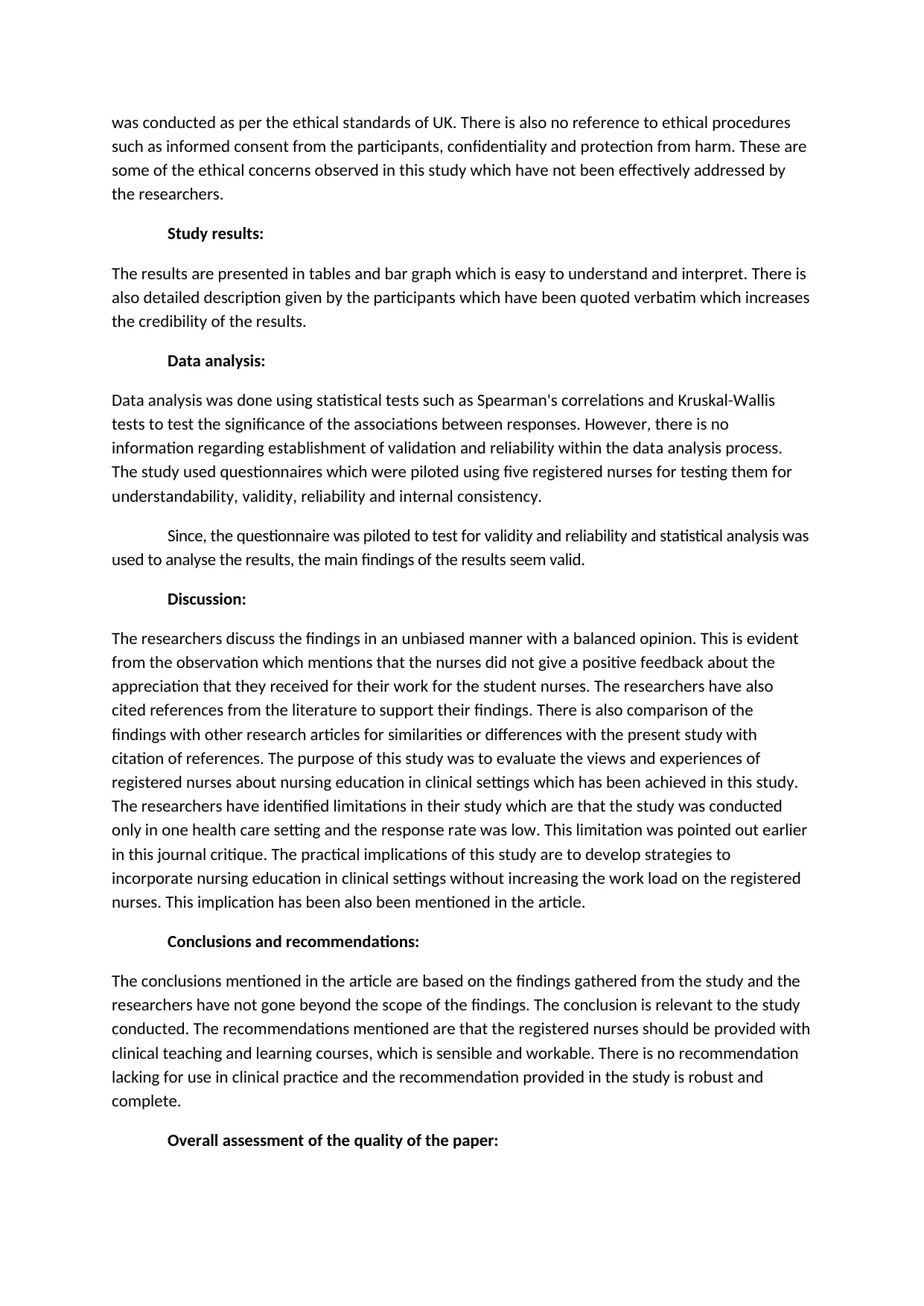
was conducted as per the ethical standards of UK. There is also no reference to ethical procedures
such as informed consent from the participants, confidentiality and protection from harm. These are
some of the ethical concerns observed in this study which have not been effectively addressed by
the researchers.
Study results:
The results are presented in tables and bar graph which is easy to understand and interpret. There is
also detailed description given by the participants which have been quoted verbatim which increases
the credibility of the results.
Data analysis:
Data analysis was done using statistical tests such as Spearman's correlations and Kruskal-Wallis
tests to test the significance of the associations between responses. However, there is no
information regarding establishment of validation and reliability within the data analysis process.
The study used questionnaires which were piloted using five registered nurses for testing them for
understandability, validity, reliability and internal consistency.
Since, the questionnaire was piloted to test for validity and reliability and statistical analysis was
used to analyse the results, the main findings of the results seem valid.
Discussion:
The researchers discuss the findings in an unbiased manner with a balanced opinion. This is evident
from the observation which mentions that the nurses did not give a positive feedback about the
appreciation that they received for their work for the student nurses. The researchers have also
cited references from the literature to support their findings. There is also comparison of the
findings with other research articles for similarities or differences with the present study with
citation of references. The purpose of this study was to evaluate the views and experiences of
registered nurses about nursing education in clinical settings which has been achieved in this study.
The researchers have identified limitations in their study which are that the study was conducted
only in one health care setting and the response rate was low. This limitation was pointed out earlier
in this journal critique. The practical implications of this study are to develop strategies to
incorporate nursing education in clinical settings without increasing the work load on the registered
nurses. This implication has been also been mentioned in the article.
Conclusions and recommendations:
The conclusions mentioned in the article are based on the findings gathered from the study and the
researchers have not gone beyond the scope of the findings. The conclusion is relevant to the study
conducted. The recommendations mentioned are that the registered nurses should be provided with
clinical teaching and learning courses, which is sensible and workable. There is no recommendation
lacking for use in clinical practice and the recommendation provided in the study is robust and
complete.
Overall assessment of the quality of the paper:
such as informed consent from the participants, confidentiality and protection from harm. These are
some of the ethical concerns observed in this study which have not been effectively addressed by
the researchers.
Study results:
The results are presented in tables and bar graph which is easy to understand and interpret. There is
also detailed description given by the participants which have been quoted verbatim which increases
the credibility of the results.
Data analysis:
Data analysis was done using statistical tests such as Spearman's correlations and Kruskal-Wallis
tests to test the significance of the associations between responses. However, there is no
information regarding establishment of validation and reliability within the data analysis process.
The study used questionnaires which were piloted using five registered nurses for testing them for
understandability, validity, reliability and internal consistency.
Since, the questionnaire was piloted to test for validity and reliability and statistical analysis was
used to analyse the results, the main findings of the results seem valid.
Discussion:
The researchers discuss the findings in an unbiased manner with a balanced opinion. This is evident
from the observation which mentions that the nurses did not give a positive feedback about the
appreciation that they received for their work for the student nurses. The researchers have also
cited references from the literature to support their findings. There is also comparison of the
findings with other research articles for similarities or differences with the present study with
citation of references. The purpose of this study was to evaluate the views and experiences of
registered nurses about nursing education in clinical settings which has been achieved in this study.
The researchers have identified limitations in their study which are that the study was conducted
only in one health care setting and the response rate was low. This limitation was pointed out earlier
in this journal critique. The practical implications of this study are to develop strategies to
incorporate nursing education in clinical settings without increasing the work load on the registered
nurses. This implication has been also been mentioned in the article.
Conclusions and recommendations:
The conclusions mentioned in the article are based on the findings gathered from the study and the
researchers have not gone beyond the scope of the findings. The conclusion is relevant to the study
conducted. The recommendations mentioned are that the registered nurses should be provided with
clinical teaching and learning courses, which is sensible and workable. There is no recommendation
lacking for use in clinical practice and the recommendation provided in the study is robust and
complete.
Overall assessment of the quality of the paper:
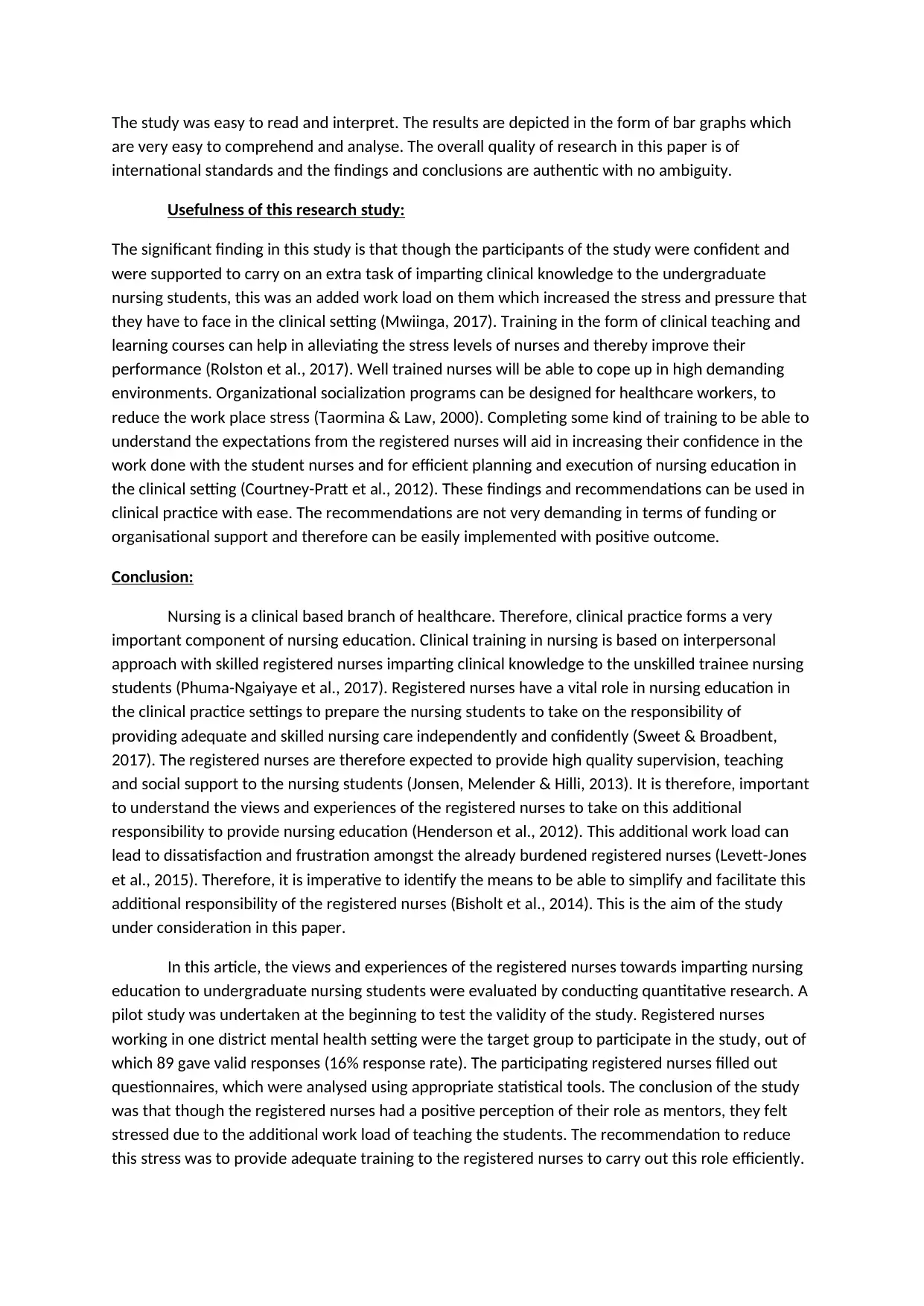
The study was easy to read and interpret. The results are depicted in the form of bar graphs which
are very easy to comprehend and analyse. The overall quality of research in this paper is of
international standards and the findings and conclusions are authentic with no ambiguity.
Usefulness of this research study:
The significant finding in this study is that though the participants of the study were confident and
were supported to carry on an extra task of imparting clinical knowledge to the undergraduate
nursing students, this was an added work load on them which increased the stress and pressure that
they have to face in the clinical setting (Mwiinga, 2017). Training in the form of clinical teaching and
learning courses can help in alleviating the stress levels of nurses and thereby improve their
performance (Rolston et al., 2017). Well trained nurses will be able to cope up in high demanding
environments. Organizational socialization programs can be designed for healthcare workers, to
reduce the work place stress (Taormina & Law, 2000). Completing some kind of training to be able to
understand the expectations from the registered nurses will aid in increasing their confidence in the
work done with the student nurses and for efficient planning and execution of nursing education in
the clinical setting (Courtney-Pratt et al., 2012). These findings and recommendations can be used in
clinical practice with ease. The recommendations are not very demanding in terms of funding or
organisational support and therefore can be easily implemented with positive outcome.
Conclusion:
Nursing is a clinical based branch of healthcare. Therefore, clinical practice forms a very
important component of nursing education. Clinical training in nursing is based on interpersonal
approach with skilled registered nurses imparting clinical knowledge to the unskilled trainee nursing
students (Phuma-Ngaiyaye et al., 2017). Registered nurses have a vital role in nursing education in
the clinical practice settings to prepare the nursing students to take on the responsibility of
providing adequate and skilled nursing care independently and confidently (Sweet & Broadbent,
2017). The registered nurses are therefore expected to provide high quality supervision, teaching
and social support to the nursing students (Jonsen, Melender & Hilli, 2013). It is therefore, important
to understand the views and experiences of the registered nurses to take on this additional
responsibility to provide nursing education (Henderson et al., 2012). This additional work load can
lead to dissatisfaction and frustration amongst the already burdened registered nurses (Levett-Jones
et al., 2015). Therefore, it is imperative to identify the means to be able to simplify and facilitate this
additional responsibility of the registered nurses (Bisholt et al., 2014). This is the aim of the study
under consideration in this paper.
In this article, the views and experiences of the registered nurses towards imparting nursing
education to undergraduate nursing students were evaluated by conducting quantitative research. A
pilot study was undertaken at the beginning to test the validity of the study. Registered nurses
working in one district mental health setting were the target group to participate in the study, out of
which 89 gave valid responses (16% response rate). The participating registered nurses filled out
questionnaires, which were analysed using appropriate statistical tools. The conclusion of the study
was that though the registered nurses had a positive perception of their role as mentors, they felt
stressed due to the additional work load of teaching the students. The recommendation to reduce
this stress was to provide adequate training to the registered nurses to carry out this role efficiently.
are very easy to comprehend and analyse. The overall quality of research in this paper is of
international standards and the findings and conclusions are authentic with no ambiguity.
Usefulness of this research study:
The significant finding in this study is that though the participants of the study were confident and
were supported to carry on an extra task of imparting clinical knowledge to the undergraduate
nursing students, this was an added work load on them which increased the stress and pressure that
they have to face in the clinical setting (Mwiinga, 2017). Training in the form of clinical teaching and
learning courses can help in alleviating the stress levels of nurses and thereby improve their
performance (Rolston et al., 2017). Well trained nurses will be able to cope up in high demanding
environments. Organizational socialization programs can be designed for healthcare workers, to
reduce the work place stress (Taormina & Law, 2000). Completing some kind of training to be able to
understand the expectations from the registered nurses will aid in increasing their confidence in the
work done with the student nurses and for efficient planning and execution of nursing education in
the clinical setting (Courtney-Pratt et al., 2012). These findings and recommendations can be used in
clinical practice with ease. The recommendations are not very demanding in terms of funding or
organisational support and therefore can be easily implemented with positive outcome.
Conclusion:
Nursing is a clinical based branch of healthcare. Therefore, clinical practice forms a very
important component of nursing education. Clinical training in nursing is based on interpersonal
approach with skilled registered nurses imparting clinical knowledge to the unskilled trainee nursing
students (Phuma-Ngaiyaye et al., 2017). Registered nurses have a vital role in nursing education in
the clinical practice settings to prepare the nursing students to take on the responsibility of
providing adequate and skilled nursing care independently and confidently (Sweet & Broadbent,
2017). The registered nurses are therefore expected to provide high quality supervision, teaching
and social support to the nursing students (Jonsen, Melender & Hilli, 2013). It is therefore, important
to understand the views and experiences of the registered nurses to take on this additional
responsibility to provide nursing education (Henderson et al., 2012). This additional work load can
lead to dissatisfaction and frustration amongst the already burdened registered nurses (Levett-Jones
et al., 2015). Therefore, it is imperative to identify the means to be able to simplify and facilitate this
additional responsibility of the registered nurses (Bisholt et al., 2014). This is the aim of the study
under consideration in this paper.
In this article, the views and experiences of the registered nurses towards imparting nursing
education to undergraduate nursing students were evaluated by conducting quantitative research. A
pilot study was undertaken at the beginning to test the validity of the study. Registered nurses
working in one district mental health setting were the target group to participate in the study, out of
which 89 gave valid responses (16% response rate). The participating registered nurses filled out
questionnaires, which were analysed using appropriate statistical tools. The conclusion of the study
was that though the registered nurses had a positive perception of their role as mentors, they felt
stressed due to the additional work load of teaching the students. The recommendation to reduce
this stress was to provide adequate training to the registered nurses to carry out this role efficiently.
⊘ This is a preview!⊘
Do you want full access?
Subscribe today to unlock all pages.

Trusted by 1+ million students worldwide
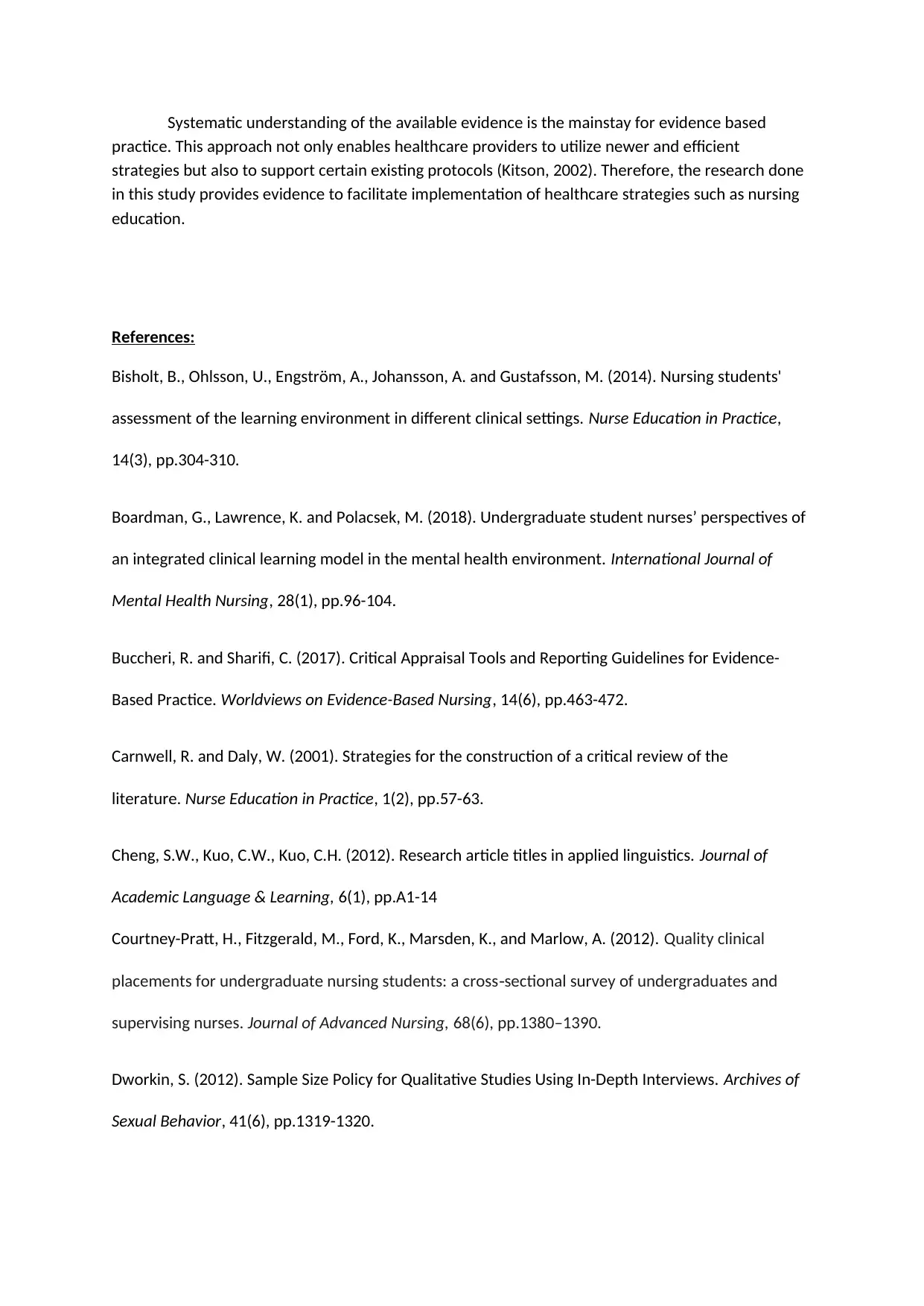
Systematic understanding of the available evidence is the mainstay for evidence based
practice. This approach not only enables healthcare providers to utilize newer and efficient
strategies but also to support certain existing protocols (Kitson, 2002). Therefore, the research done
in this study provides evidence to facilitate implementation of healthcare strategies such as nursing
education.
References:
Bisholt, B., Ohlsson, U., Engström, A., Johansson, A. and Gustafsson, M. (2014). Nursing students'
assessment of the learning environment in different clinical settings. Nurse Education in Practice,
14(3), pp.304-310.
Boardman, G., Lawrence, K. and Polacsek, M. (2018). Undergraduate student nurses’ perspectives of
an integrated clinical learning model in the mental health environment. International Journal of
Mental Health Nursing, 28(1), pp.96-104.
Buccheri, R. and Sharifi, C. (2017). Critical Appraisal Tools and Reporting Guidelines for Evidence-
Based Practice. Worldviews on Evidence-Based Nursing, 14(6), pp.463-472.
Carnwell, R. and Daly, W. (2001). Strategies for the construction of a critical review of the
literature. Nurse Education in Practice, 1(2), pp.57-63.
Cheng, S.W., Kuo, C.W., Kuo, C.H. (2012). Research article titles in applied linguistics. Journal of
Academic Language & Learning, 6(1), pp.A1-14
Courtney-Pratt, H., Fitzgerald, M., Ford, K., Marsden, K., and Marlow, A. (2012). Quality clinical
placements for undergraduate nursing students: a cross sectional survey of undergraduates and‐
supervising nurses. Journal of Advanced Nursing, 68(6), pp.1380–1390.
Dworkin, S. (2012). Sample Size Policy for Qualitative Studies Using In-Depth Interviews. Archives of
Sexual Behavior, 41(6), pp.1319-1320.
practice. This approach not only enables healthcare providers to utilize newer and efficient
strategies but also to support certain existing protocols (Kitson, 2002). Therefore, the research done
in this study provides evidence to facilitate implementation of healthcare strategies such as nursing
education.
References:
Bisholt, B., Ohlsson, U., Engström, A., Johansson, A. and Gustafsson, M. (2014). Nursing students'
assessment of the learning environment in different clinical settings. Nurse Education in Practice,
14(3), pp.304-310.
Boardman, G., Lawrence, K. and Polacsek, M. (2018). Undergraduate student nurses’ perspectives of
an integrated clinical learning model in the mental health environment. International Journal of
Mental Health Nursing, 28(1), pp.96-104.
Buccheri, R. and Sharifi, C. (2017). Critical Appraisal Tools and Reporting Guidelines for Evidence-
Based Practice. Worldviews on Evidence-Based Nursing, 14(6), pp.463-472.
Carnwell, R. and Daly, W. (2001). Strategies for the construction of a critical review of the
literature. Nurse Education in Practice, 1(2), pp.57-63.
Cheng, S.W., Kuo, C.W., Kuo, C.H. (2012). Research article titles in applied linguistics. Journal of
Academic Language & Learning, 6(1), pp.A1-14
Courtney-Pratt, H., Fitzgerald, M., Ford, K., Marsden, K., and Marlow, A. (2012). Quality clinical
placements for undergraduate nursing students: a cross sectional survey of undergraduates and‐
supervising nurses. Journal of Advanced Nursing, 68(6), pp.1380–1390.
Dworkin, S. (2012). Sample Size Policy for Qualitative Studies Using In-Depth Interviews. Archives of
Sexual Behavior, 41(6), pp.1319-1320.
Paraphrase This Document
Need a fresh take? Get an instant paraphrase of this document with our AI Paraphraser
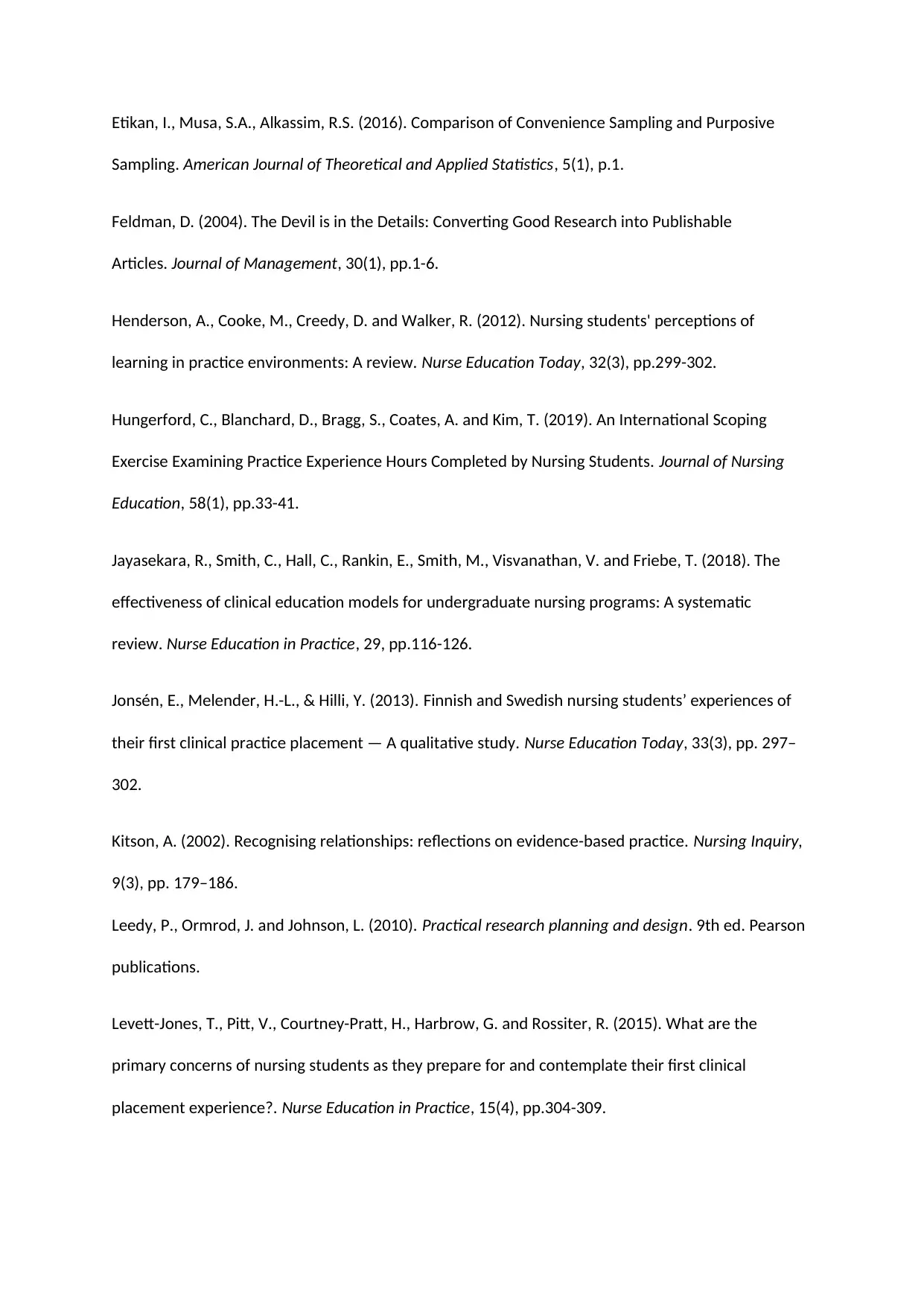
Etikan, I., Musa, S.A., Alkassim, R.S. (2016). Comparison of Convenience Sampling and Purposive
Sampling. American Journal of Theoretical and Applied Statistics, 5(1), p.1.
Feldman, D. (2004). The Devil is in the Details: Converting Good Research into Publishable
Articles. Journal of Management, 30(1), pp.1-6.
Henderson, A., Cooke, M., Creedy, D. and Walker, R. (2012). Nursing students' perceptions of
learning in practice environments: A review. Nurse Education Today, 32(3), pp.299-302.
Hungerford, C., Blanchard, D., Bragg, S., Coates, A. and Kim, T. (2019). An International Scoping
Exercise Examining Practice Experience Hours Completed by Nursing Students. Journal of Nursing
Education, 58(1), pp.33-41.
Jayasekara, R., Smith, C., Hall, C., Rankin, E., Smith, M., Visvanathan, V. and Friebe, T. (2018). The
effectiveness of clinical education models for undergraduate nursing programs: A systematic
review. Nurse Education in Practice, 29, pp.116-126.
Jonsén, E., Melender, H.-L., & Hilli, Y. (2013). Finnish and Swedish nursing students’ experiences of
their first clinical practice placement — A qualitative study. Nurse Education Today, 33(3), pp. 297–
302.
Kitson, A. (2002). Recognising relationships: reflections on evidence-based practice. Nursing Inquiry,
9(3), pp. 179–186.
Leedy, P., Ormrod, J. and Johnson, L. (2010). Practical research planning and design. 9th ed. Pearson
publications.
Levett-Jones, T., Pitt, V., Courtney-Pratt, H., Harbrow, G. and Rossiter, R. (2015). What are the
primary concerns of nursing students as they prepare for and contemplate their first clinical
placement experience?. Nurse Education in Practice, 15(4), pp.304-309.
Sampling. American Journal of Theoretical and Applied Statistics, 5(1), p.1.
Feldman, D. (2004). The Devil is in the Details: Converting Good Research into Publishable
Articles. Journal of Management, 30(1), pp.1-6.
Henderson, A., Cooke, M., Creedy, D. and Walker, R. (2012). Nursing students' perceptions of
learning in practice environments: A review. Nurse Education Today, 32(3), pp.299-302.
Hungerford, C., Blanchard, D., Bragg, S., Coates, A. and Kim, T. (2019). An International Scoping
Exercise Examining Practice Experience Hours Completed by Nursing Students. Journal of Nursing
Education, 58(1), pp.33-41.
Jayasekara, R., Smith, C., Hall, C., Rankin, E., Smith, M., Visvanathan, V. and Friebe, T. (2018). The
effectiveness of clinical education models for undergraduate nursing programs: A systematic
review. Nurse Education in Practice, 29, pp.116-126.
Jonsén, E., Melender, H.-L., & Hilli, Y. (2013). Finnish and Swedish nursing students’ experiences of
their first clinical practice placement — A qualitative study. Nurse Education Today, 33(3), pp. 297–
302.
Kitson, A. (2002). Recognising relationships: reflections on evidence-based practice. Nursing Inquiry,
9(3), pp. 179–186.
Leedy, P., Ormrod, J. and Johnson, L. (2010). Practical research planning and design. 9th ed. Pearson
publications.
Levett-Jones, T., Pitt, V., Courtney-Pratt, H., Harbrow, G. and Rossiter, R. (2015). What are the
primary concerns of nursing students as they prepare for and contemplate their first clinical
placement experience?. Nurse Education in Practice, 15(4), pp.304-309.
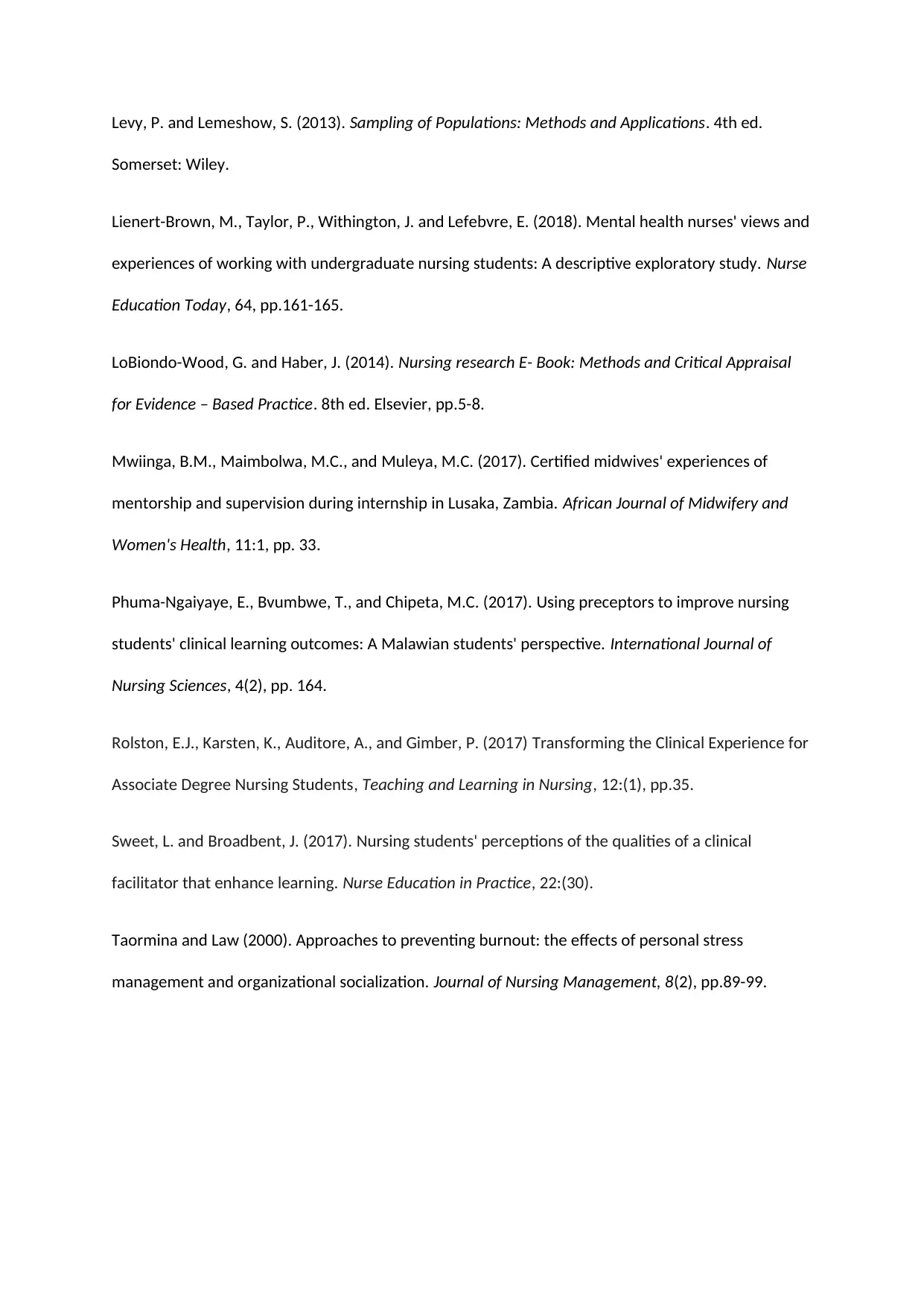
Levy, P. and Lemeshow, S. (2013). Sampling of Populations: Methods and Applications. 4th ed.
Somerset: Wiley.
Lienert-Brown, M., Taylor, P., Withington, J. and Lefebvre, E. (2018). Mental health nurses' views and
experiences of working with undergraduate nursing students: A descriptive exploratory study. Nurse
Education Today, 64, pp.161-165.
LoBiondo-Wood, G. and Haber, J. (2014). Nursing research E- Book: Methods and Critical Appraisal
for Evidence – Based Practice. 8th ed. Elsevier, pp.5-8.
Mwiinga, B.M., Maimbolwa, M.C., and Muleya, M.C. (2017). Certified midwives' experiences of
mentorship and supervision during internship in Lusaka, Zambia. African Journal of Midwifery and
Women's Health, 11:1, pp. 33.
Phuma-Ngaiyaye, E., Bvumbwe, T., and Chipeta, M.C. (2017). Using preceptors to improve nursing
students' clinical learning outcomes: A Malawian students' perspective. International Journal of
Nursing Sciences, 4(2), pp. 164.
Rolston, E.J., Karsten, K., Auditore, A., and Gimber, P. (2017) Transforming the Clinical Experience for
Associate Degree Nursing Students, Teaching and Learning in Nursing, 12:(1), pp.35.
Sweet, L. and Broadbent, J. (2017). Nursing students' perceptions of the qualities of a clinical
facilitator that enhance learning. Nurse Education in Practice, 22:(30).
Taormina and Law (2000). Approaches to preventing burnout: the effects of personal stress
management and organizational socialization. Journal of Nursing Management, 8(2), pp.89-99.
Somerset: Wiley.
Lienert-Brown, M., Taylor, P., Withington, J. and Lefebvre, E. (2018). Mental health nurses' views and
experiences of working with undergraduate nursing students: A descriptive exploratory study. Nurse
Education Today, 64, pp.161-165.
LoBiondo-Wood, G. and Haber, J. (2014). Nursing research E- Book: Methods and Critical Appraisal
for Evidence – Based Practice. 8th ed. Elsevier, pp.5-8.
Mwiinga, B.M., Maimbolwa, M.C., and Muleya, M.C. (2017). Certified midwives' experiences of
mentorship and supervision during internship in Lusaka, Zambia. African Journal of Midwifery and
Women's Health, 11:1, pp. 33.
Phuma-Ngaiyaye, E., Bvumbwe, T., and Chipeta, M.C. (2017). Using preceptors to improve nursing
students' clinical learning outcomes: A Malawian students' perspective. International Journal of
Nursing Sciences, 4(2), pp. 164.
Rolston, E.J., Karsten, K., Auditore, A., and Gimber, P. (2017) Transforming the Clinical Experience for
Associate Degree Nursing Students, Teaching and Learning in Nursing, 12:(1), pp.35.
Sweet, L. and Broadbent, J. (2017). Nursing students' perceptions of the qualities of a clinical
facilitator that enhance learning. Nurse Education in Practice, 22:(30).
Taormina and Law (2000). Approaches to preventing burnout: the effects of personal stress
management and organizational socialization. Journal of Nursing Management, 8(2), pp.89-99.
⊘ This is a preview!⊘
Do you want full access?
Subscribe today to unlock all pages.

Trusted by 1+ million students worldwide

1 out of 10
Related Documents
Your All-in-One AI-Powered Toolkit for Academic Success.
+13062052269
info@desklib.com
Available 24*7 on WhatsApp / Email
![[object Object]](/_next/static/media/star-bottom.7253800d.svg)
Unlock your academic potential
Copyright © 2020–2025 A2Z Services. All Rights Reserved. Developed and managed by ZUCOL.





